What is a capacitor for beginners?You need to understand these knowledge


Capacitors are one of the most basic and important components in electronics, playing the role of storing charge and energy in circuits. Whether it's a simple power filter circuit or a complex digital signal processing system, capacitors are an indispensable presence. This article will delve into the fundamentals, types, applications and importance of capacitors in modern electronics.
Overview of Capacitors
A capacitor is a passive electronic component capable of storing electrical charge. It consists of two conductors (often referred to as poles) that are separated by an insulating material called a dielectric. When a voltage is applied to the ends of the capacitor, charge builds up on the two plates, thus storing energy in the capacitor.Capacitor Formula
The basic parameters of a capacitor include capacitance (C), voltage (V), and charge (Q), and the relationship between them can be expressed by the formula Q = C × V.Unit of Capacitor
The unit of capacitance is the farad (F), but in practice the commonly used units are the microfarad (µF), nanofarad (nF) and picofarad (pF).What does the capacitance of a capacitor depend on?
The capacitance of a capacitor depends on three main factors:
- Plate area: The larger the plate area, the higher the capacitance.
- Distance between the plates: the closer the plates, the higher the capacitance.
- Dielectric material: The type of insulating material between the plates affects the capacitance. Different materials have different dielectric constants, which affects the performance of the capacitor.
Types of capacitors and their characteristics
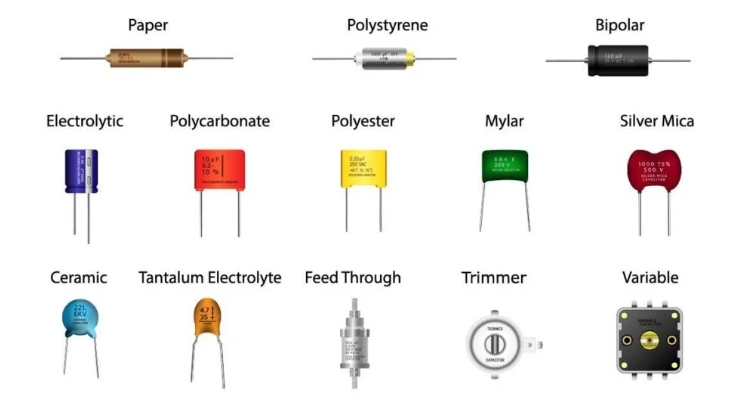
- Electrolytic capacitors: These capacitors are usually used in applications that require high capacitance, such as power supply filtering and signal coupling. Electrolytic capacitors have high capacitance and low cost, but they have a shorter life and poorer temperature stability.
- Ceramic capacitors: Ceramic capacitors are known for their high stability and high temperature resistance. They are widely used in radio frequency (RF) circuits and high frequency circuits. However, ceramic capacitors have a relatively small capacitance.
- Film Capacitors: Film capacitors are made of alternating layers of metal foil and plastic film. They have good frequency characteristics and temperature stability and are commonly used in audio equipment and power systems.
- Ultracapacitors: Ultracapacitors, also known as double layer capacitors, have a much higher capacity than ordinary capacitors, up to thousands of farads. Ultracapacitors combine the advantages of both batteries and capacitors, and can release large amounts of energy in a short period of time, and are widely used in electric vehicles, backup power and energy recovery systems.
What are the main uses of capacitors?
Capacitors play an important role in various electronic devices and circuits due to their unique properties, the following are the main uses of capacitors:
- Power Filtering: Capacitors smooth out ripple in the power supply voltage, eliminate high frequency noise in the power supply, and provide a more stable DC power supply. This is one of the most common uses of capacitors, especially important in applications that require a stable power supply.
- Coupling and Bypassing: During signal transmission, capacitors are used to couple signals between different circuits, while bypassing unwanted DC components and allowing only AC signals to pass through. This is very important for signal cleaning and isolation.
- Timing and Oscillation: In timing and oscillation circuits, capacitors are used in conjunction with resistors to produce precisely timed or oscillating signals. This is critical for applications that require timing control or the generation of a specific frequency signal.
- Energy Storage: Capacitors can store electrical energy for applications that require a quick release of energy, such as flash circuits and starter motors. Supercapacitors are capable of storing even larger amounts of energy and are used in applications that require rapid charging and discharging, such as energy recovery systems and backup power.
- Signal processing: In audio and RF circuits, capacitors are used for tasks such as filtering, coupling and signal modulation. They can help filter out unwanted frequency components and improve signal purity.
- Temperature compensation: In some applications, capacitors can be used to compensate for changes in circuit parameters due to temperature variations, ensuring circuit stability at different temperatures.
- Protection circuits: Capacitors can also be used to protect circuits, for example, in overvoltage protection circuits, capacitors can absorb instantaneous high-voltage pulses to prevent damage to sensitive electronic components.
- Charging and discharging: During charging and discharging, capacitors are able to temporarily store electrical energy and release it when needed. This characteristic is useful in applications that require a short supply of energy.
- Phase Shift: In some circuits, capacitors can be used to change the phase relationship of voltages or currents, which is important for some specific applications.
- Capacitive Feedback: In amplifier circuits, capacitors can be used to provide capacitive feedback to improve the stability of the amplifier.
- Trigger Circuits: In trigger circuits, capacitors can be used to generate the necessary delay time to ensure proper triggering of the circuit.
- Coupled Inductor: In coupled inductor circuits, capacitors can be used to improve the coupling efficiency of the circuit, which is important for applications requiring high coupling.
- Tuned Circuits: In radio and communications equipment, capacitors can be used to tune circuits to receive or transmit signals at specific frequencies.
- Digital Circuits: In digital circuits, capacitors can be used to store charge for triggering and memory functions.
- Motor Starting: In some types of motor starting circuits, capacitors can be used to provide an initial starting torque to help the motor begin to spin.
- Battery Management Systems: In battery management systems, capacitors can be used to smooth out voltage fluctuations during battery charging and discharging, protecting the battery from overcharging or overdischarging.
- Power Electronics: In power electronics, capacitors can be used for filtering, voltage stabilization and energy storage, and are critical for improving power conversion efficiency and stability.
- Sensors: In certain types of sensors, capacitors can be used to detect changes in physical parameters such as pressure, humidity, etc.
- Medical Devices: In medical devices, capacitors can be used to smooth power supply voltages, filtering and energy storage, and are critical to ensuring the reliability and accuracy of medical devices.
- Automotive electronics: In automotive electronics, capacitors can be used for filtering, voltage stabilization, and energy storage, and are vital for improving the performance and reliability of vehicle electronic systems.
Common Capacitor Symbols
- Electrolytic Capacitor Symbols

- Aluminum Electrolytic Capacitors
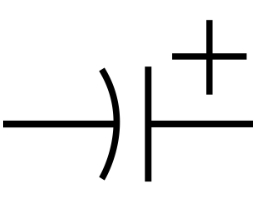
- Ceramic Capacitor Symbols

- Film Capacitor Symbols
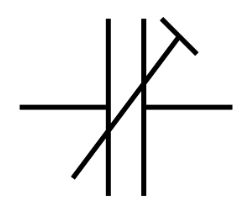
- Supercapacitor Symbols

- Variable Vacuum Capacitors
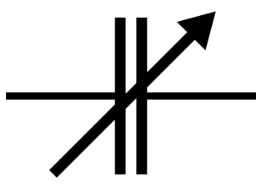
- Motor Run and Start Capacitor Symbols
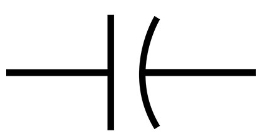
What is the capacitor symbol on a multimeter?
To find the capacitor symbol on a multimeter, you first need to determine if the multimeter has the capability to measure capacitance. Not all multimeters have this capability, but many modern digital multimeters (DMMs) can measure capacitance.Capacitance is measured in farads, usually in microfarads (uF), nanofarads (nF), or picofarads (pF). On a multimeter, the symbol for capacitance is usually a symbol similar to the letter “F” or a simple graphic of a capacitor represented by a wireframe. Find the symbol for capacitors on a multimeter. This is usually the letter “F”, or a simple graphic of a capacitor.
How to test a capacitor with a multimeter and analyze the results
Preparation Tools:
- Multimeter: Make sure the multimeter has a capacitance measurement function.
- Capacitor to be tested: The capacitor to be checked.
- Lead wires: for connecting the multimeter and the capacitor.
Steps:
Prepare the capacitor
- Make sure the capacitor is fully discharged before starting the measurement. If the capacitor was previously energized, wait for some time to allow the capacitor to discharge on its own, or use a safe method of discharging to avoid the risk of electric shock.
Setting the multimeter:
- Set the multimeter to the capacitance measurement mode (usually denoted by the letter “F”, e.g. “μF”, “nF”, etc.).
- Make sure that the multimeter's range is set to the appropriate capacitance range. For example, if you are measuring a 10 μF capacitor, make sure the range is set above 10 μF.
Connect the capacitor:
- Use the multimeter's probes to connect the two terminals of the capacitor. For polarized capacitors, note the correct polarity connection (red probe connects to positive terminal, black probe connects to negative terminal).
- For non-polar capacitors, feel free to connect them.
Read the results:
- Observe the reading on the multimeter screen. If the capacitor is intact, the reading should be close to the nominal value.
- If the reading is much higher or lower than the nominal value, or the display shows “OL” (out of range), the capacitor may be defective.
Determine the status of the capacitor:
- Normal: If the reading is close to the nominal value of the capacitor, the capacitor is in good condition.
- Short Circuit: If the reading is 0 or a very small value, the capacitor may be shorted internally.
- Open Circuit: If the reading shows infinity or is out of range, the capacitor may be internally disconnected.
- Leakage: If the reading gradually decreases over time, there may be a leakage.
Repeat the measurement (if necessary):
- If in doubt about the results of the initial measurement, repeat the above steps for reconfirmation.
Record results:
- Record the measurement results of the capacitor, including the capacitance value and possible status judgment.
Statement
All articles (images, texts, audio) on this site are uploaded and shared by users, or integrated from relevant internet sources, only for user's learning. If your rights are violated, please contact the administrator to delete! Link to this article: https://www.jinftry.com







